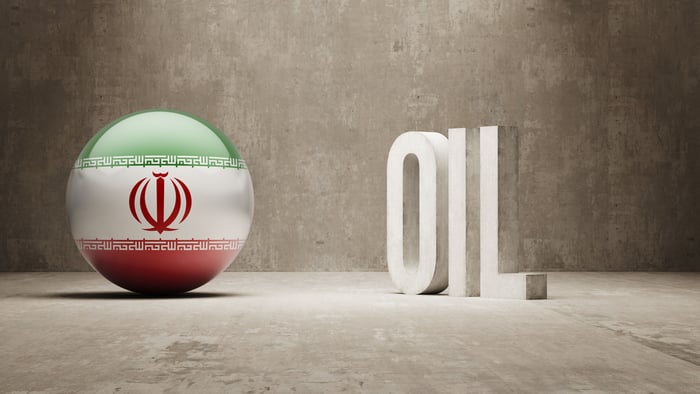
Image source: Getty Images.
Oil prices have been stubbornly weak this year, spending much of the time below $50 a barrel when many expected it to be well over that level by now. However, while oil remains comfortably below triple digits, that doesn't mean it couldn't eventually regain that level. In fact, there's a growing chorus of analysts who are worried that crude prices could spike in the future. Here's a look at five scenarios that could push oil back over $100 a barrel, especially if two or more combined at the same time.

Image source: Getty Images.
1. OPEC empties out the barrel
Members of OPEC, along with several nonmembers, have agreed to reduce their combined output by 1.8 million barrels per day (Bpd) to help drain some of the excess supply sitting in storage, which has been weighing on oil prices. So far, OPEC has done an excellent job of adhering to its pledge given that compliance has averaged 86% this year. While the current agreement lasts until next March, members have openly talked about extending it, and even more recently suggested that they are open to taking "some extraordinary measures" that would sustain the rebalancing, which could include expanding membership and cutting production even deeper. That said, with inventories getting closer to the five-year average, it's possible that OPEC could go too far and drain too much oil out of the market causing prices to skyrocket, especially if there were to be an unexpected supply shock and demand continues accelerating.

Image source: Getty Images.
2. Years of underinvestment finally catches up
Three years of low oil prices have caused the industry to defer or delay a stunning $2 trillion of planned oil projects. As a result, there's limited spare capacity in the market right now, which will make it harder for many producers to keep up with the natural production decline rates of legacy oil fields. According to reservoir specialist Core Labs (CLB), the industry will need to add 2.8 million Bpd next year just to maintain current production capacity. Thus, oil companies need to ramp up investments to fight the decline rate. If they don't, an executive from Halliburton (HAL -1.04%) warned that "the market is going to catch up... you'll see some kind of spike in the price of oil. Maybe somewhere around 2020-2021, but it's got to catch up sooner or later." Core and Halliburton aren't just saying that to convince customers to start spending more money now. The International Energy Agency also recently predicted that "global oil supply could struggle to keep pace with demand after 2020, risking a sharp increase in prices, unless new projects are approved soon."

Image source: Getty Images.
3. Iran upends the oil market
One of the reasons oil prices have remained low in recent years is that the Iran quickly ramped up its oil exports after signing the nuclear deal that ended the sanctions holding it back. The country now produces 3.8 million bpd and is back up to its pre-sanction level. However, President Trump has vowed to "rip up" the Iran Nuclear Deal, which could take that oil off the market and drive prices higher. Furthermore, such a decision could infuriate the country and cause it to seek revenge. One of the ways it could do so would be to close the Strait of Hormuz, which is a crucial choke point for oil flowing out of the Persian Gulf. Tankers carry 17 million barrels of crude through that critical shipping lane each day, which if cut off, could cause oil to spike 50% or more in no time.

Image source: Getty Images.
4. From oil field to battlefield
Another potential flashpoint for oil is the ever-present potential of a military coup, major terrorist attack, or civil war in a leading oil producing nation. There are already several hot spots that could flare up including Nigeria, Libya, and Venezuela. Crude output in all three countries has ebbed and flowed due to a variety of disruptions, which has caused small ripples in oil prices. That said, an even greater concern would be an unforeseen event that sends shockwaves across the oil market, such as a coup or devastating terrorist attack in a place like Russia, Iraq, or Saudi Arabia, which could constrict exports for quite a while and leave the market starved for oil.

Image source: Getty Images.
5. A wave of destruction cripples the oil patch
In addition to a conflict-driven supply shock, there's always a risk that a natural disaster lands a devastating blow on a major oil-producing region or export hub. Luckily, the industry has only experienced glancing hits in recent years that have just temporarily curbed output. For example, wildfires in Canada's oil sands region last year caused about 400,000 Bpd to go offline in June while hurricanes Harvey and Nate in the U.S. Gulf Coast this year only caused temporary shutdowns because these natural disasters largely spared the industry of significant damage. That said, the industry might not be quite so fortunate in the future. If a string of natural disasters rips right through a couple of essential oil centers causing long-term damage, it could cause output to remain offline for quite a while, potentially fueling a massive spike in prices.


